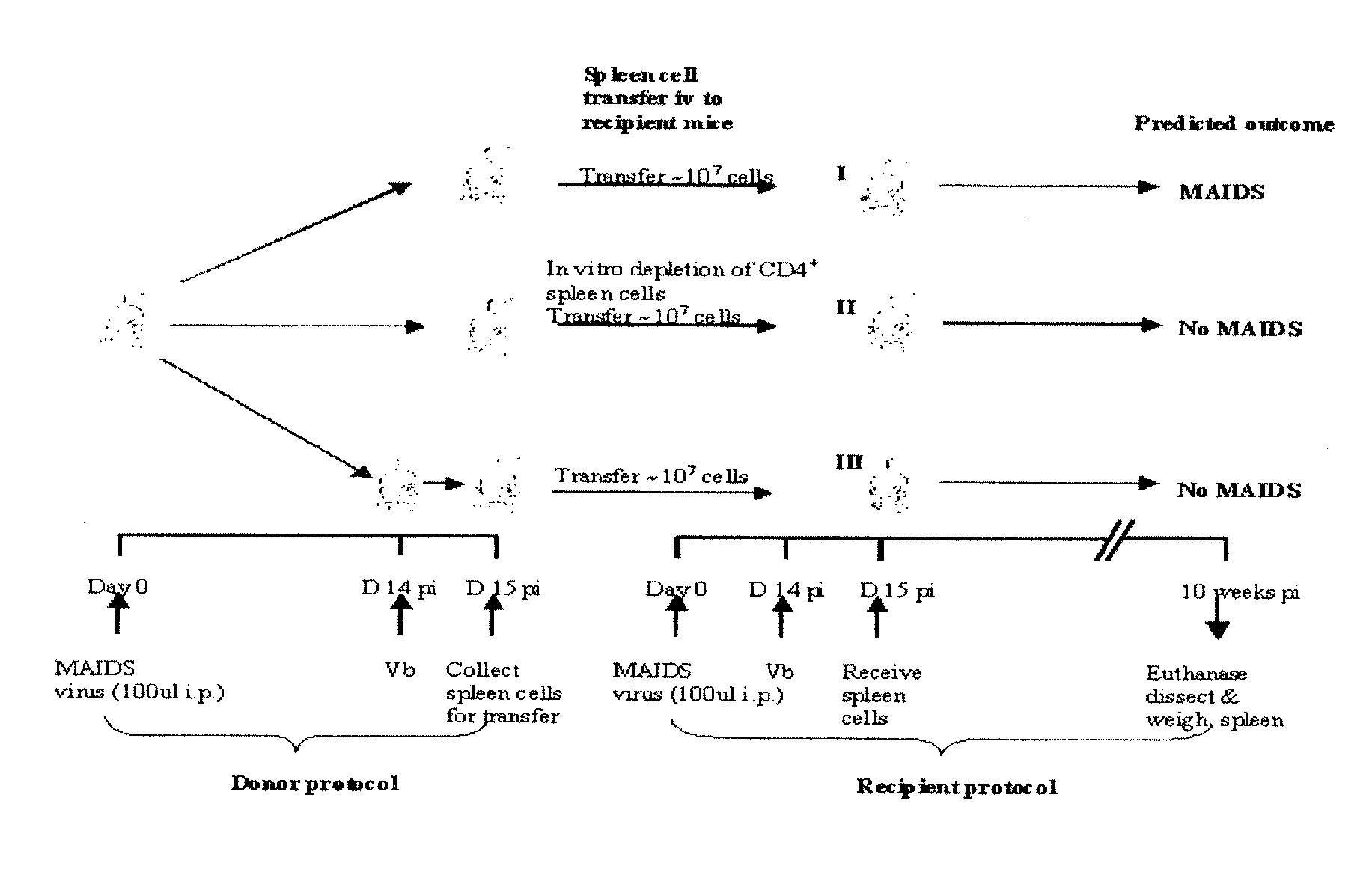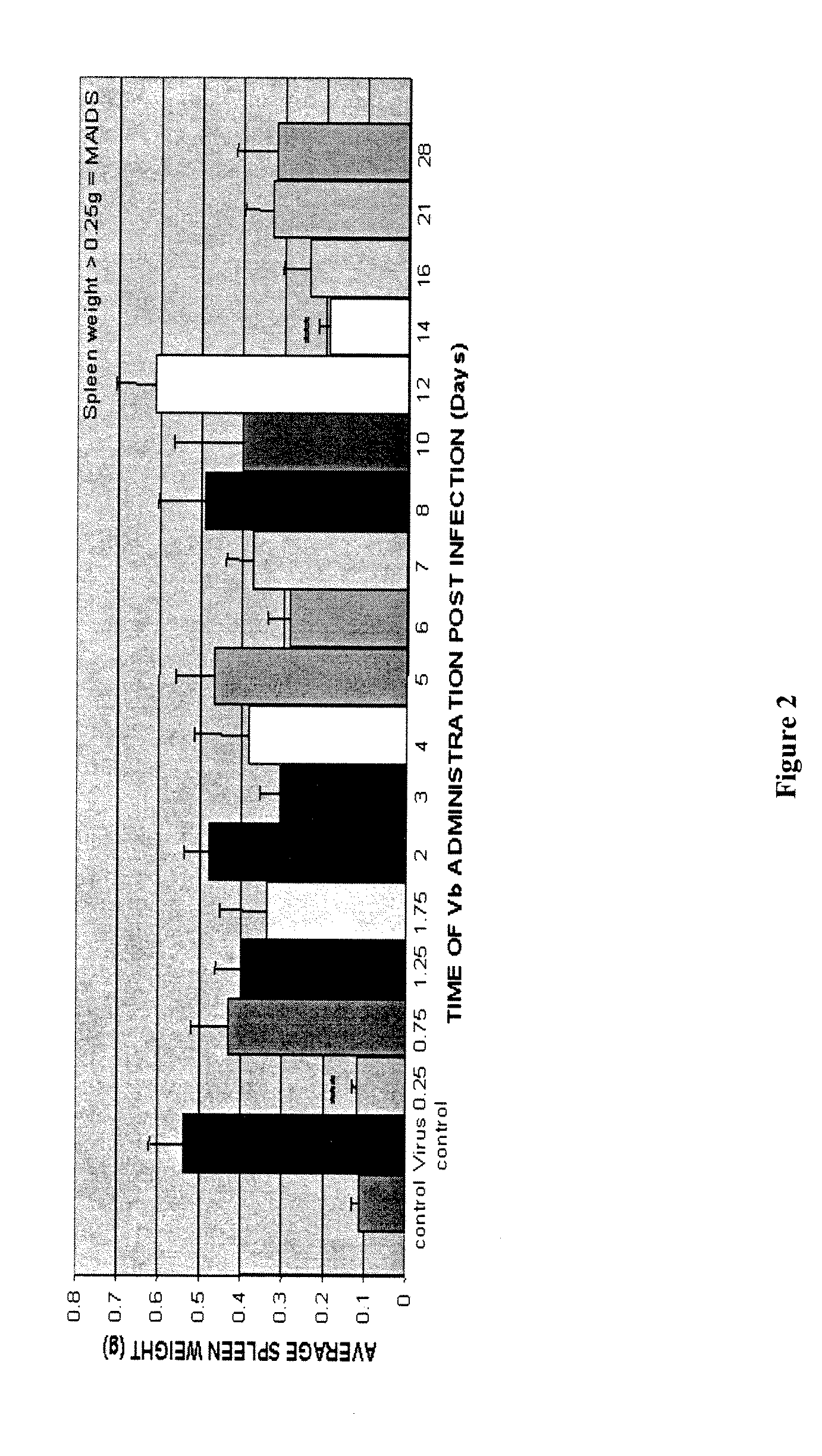Retroviral immunotherapy
a technology of immunotherapy and retroviral infection, which is applied in the field of retroviral immunotherapy, can solve the problems of limiting the ability of the immune system to mount a successful immune response, and limiting the ability of the mammal to effectively control or eradicate the retroviral infection, so as to achieve the effect of effectively controlling or eradicating the retroviral infection and limiting the ability of the mammal
- Summary
- Abstract
- Description
- Claims
- Application Information
AI Technical Summary
Benefits of technology
Problems solved by technology
Method used
Image
Examples
example 1
[0119]In order to demonstrate the present invention a murine AIDS model was used.
[0120]A murine AIDS (MAIDS) pathology induced by LP-BM5 murine leukemia virus (MuLV) in susceptible mice is an effective tool to investigate mechanisms of retrovirus-induced immunodeficiency. The MAIDS animal model displays a number of features of human AIDS. Infection of a susceptible strain such as C57BL / 6 mice with LP-BM5 leads to chronic splenomegaly, hypergammaglobulinaemia and development of immunodeficiency in both T and B cells. In vitro, there is a progressive impairment in the responsiveness of T-cells and B-cells to mitogenic or specific antigenic stimuli. In vivo, infected mice become increasingly susceptible to challenge with a variety of opportunistic organisms and can develop B-cell lymphoma. Deaths are first observed at 8-10 weeks post-infection (pi), and all mice die within 24 weeks (FIG. 1). These alterations in immune function reflect complex changes in the phenotype and function of a...
example 2
[0148]A human subject suffering from a HIV infection was subject to HAART for at least 6 months and then taken off the treatment. Viral load and c-reactive protein levels were determined using standard techniques on samples obtained during and after the completion of HAART.
[0149]As can be seen in FIG. 18, the results show that upon conclusion of HAART viral load increased. This was followed by a decrease in viral load as a result of effector cell activity which in turn was followed by another increase in viral load resulting from regulation of the effector cells. C-reactive protein levels closely mirrored viral load indicating that assays for this protein are useful as a marker for effector cell activity, as well as viral load.
example 3
[0150]A human patient suffering from an HIV infection is administered with a vaccine comprising retroviral antigenic polypeptides. Examples of such vaccines are reviewed in Dennehy (2001) and Moore et al. (2001).
[0151]Following vaccine administration, c-reactive protein levels are analysed as generally described in Example 2. Preferably, c-reactive protein levels are determined at least every 24 hours. Naturally, the patient should be examined for any indications of, for example, other viral or bacterial infections which may contribute to the elevated c-reactive protein levels. In the absence of such indications, c-reactive protein levels are continued to be monitored until levels of c-reactive protein peak and begin to decrease. Approximately when the levels of c-reactive protein begin to decrease as an indication of regulation of the effector cells the subject is administered with anti-CD4+ antibodies at a standard dose such as 300 mg.
[0152]The patient is then continued to be moni...
PUM
| Property | Measurement | Unit |
|---|---|---|
| Time | aaaaa | aaaaa |
| Level | aaaaa | aaaaa |
| Antigenicity | aaaaa | aaaaa |
Abstract
Description
Claims
Application Information
 Login to View More
Login to View More - R&D
- Intellectual Property
- Life Sciences
- Materials
- Tech Scout
- Unparalleled Data Quality
- Higher Quality Content
- 60% Fewer Hallucinations
Browse by: Latest US Patents, China's latest patents, Technical Efficacy Thesaurus, Application Domain, Technology Topic, Popular Technical Reports.
© 2025 PatSnap. All rights reserved.Legal|Privacy policy|Modern Slavery Act Transparency Statement|Sitemap|About US| Contact US: help@patsnap.com



